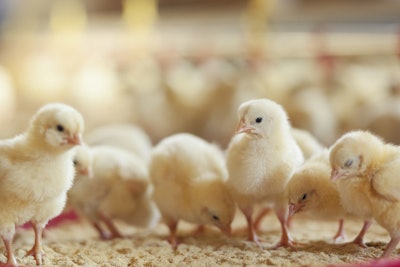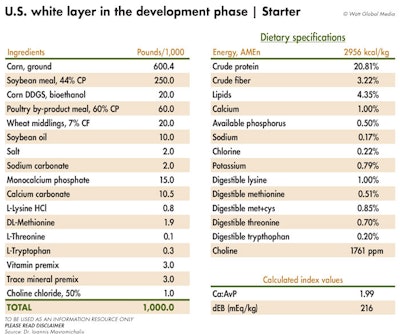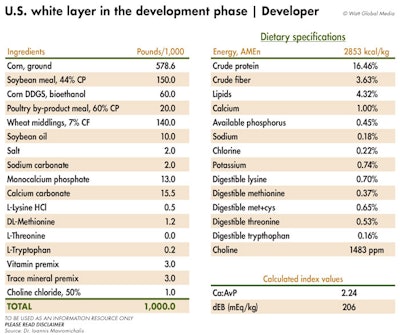Feed formulations for US white layers in the development phase
Collection of starter, grower and developer formulas for white layers during weeks 0 to 17 of the development phase
Ioannis Mavromichalis, Ph.D.

The main ingredients used in feed formulas for white U.S. layers are corn and soybean meal. In fact, it is possible to have just these two main ingredients, and a fiber source, to make a perfectly fine formula for developing pullets. However, DDGS and poultry meal are readily available and relatively inexpensive raw materials in the U.S., and as such various concentrations are being used, depending on their actual prices.
Wheat middlings, or similar high-fiber ingredients, are used to keep dietary energy levels within the rather low limits imposed to ensure pullets do not grow too fast or too fat. Soybean oil is there just to control dust in the growing facilities and facilitate pelleting of the feeds.
Micro-ingredients
For the micro-ingredients, salt is used to cover the needs only for chlorine, whereas sodium carbonate covers the remaining needs for sodium. This is important for floor-raised pullets, in order to prevent water overconsumption and wet litter issues associated with poor leg/pad health.
The feed-grade amino acids are used to keep overall protein levels low, to facilitate feeding programs without growth-promoting antimicrobials, and because these amino acids are often priced just sufficiently low enough to enable them to enter the formulas at the expense of soybean meal. A high-soybean meal diet would need just enough feed-grade methionine to cover the high needs for growing pullets.
Finally, the vitamin and trace mineral premixes are present there only to indicate their need to be added at the manufacturer’s recommended inclusion level. The actual vitamin and trace mineral levels are to be presented in a different Feed Formulation Library segment.
It merits noticing that some choline chloride is added, despite the fact that actual ingredients probably provide enough of this vitamin to cover the needs of the pullets. This addition simply reflects industry practice and indicates the lack of recent data regarding actual bird requirements.

Downloadable PDF: Starter formula for US white layers in the development phase
Nutrients
White layers are usually of low body weight and slim frame. They have a lower feed intake potential compared with brown layers. Thus, their feeds are slightly over-formulated compared with formulas destined for brown pullets.
These formulas represent a classic approach that portrays a mid-industry picture. So, the diets are classic 20/18/16% crude protein for the starter/grower/developer feeds, respectively. Actual energy levels should conform to genetic line guidelines, and here we have intermediate levels at 2950/2900/2850 kcal ME for the three feeds presented.
Calcium and phosphorus levels are again rather generous, but for growing pullets it is important to ensure proper bone calcification that requires levels above those needed for maximum weight growth. In fact, some guidelines call for even higher levels. The requirements for sodium and chlorine are adequate for pullets.
Finally, the amino acid levels are rather generous for some genetic lines, whereas they may be inadequate for others. The important aspect is that levels drop as pullets age. Some amino acids never become limiting when enough soybean meal is used, as is the case here with threonine, which does not require supplementation via L-Threonine, and actual levels are slightly higher than targets.

Downloadable PDF: Grower formula for US white layers in the development phase
Feed allowance
In general, the pullet development phase ends at about 16 or 17 weeks of age, when birds are moved into the layer facilities. The development phase is roughly divided into three equal segments. An example is as follows:
Starter = 1 to 5 weeks of age
Grower = 6 to 10 weeks of age
Developer = 11 to 16/17 weeks of age
Pullet body weight and frame size should be monitored weekly. If performance is below growth targets recommended by the genetic supplier, then the feed should be extended until birds reach their targets. The reverse is also true: If birds overconsume feed and they grow faster than anticipated, then they can be switched to the next feed sooner. Alternatively, feeds can be made more or less dense in nutrients to properly adjust growth of the pullets.

Downloadable PDF: Developer formula for US white layers in the development phase
Download the spreadsheet
Layer Feed Formulations are available in a downloadable MS Excel spreadsheet, which includes four sets of formulas — U.S. white and EU red in the development and production phases — with three variations each: starter, grower and developer.
DOWNLOAD Layer Feed Formulations
Additional installments in the Layer Feed Formulations series:
- How layer feed formulas for US white and EU red layers were created
- Feed formulas for U.S. white layers during the production phase | Weeks 18 to 100
- Feed formulas for EU red layers during the development phase | Weeks 0 to 17
- Feed formulas for EU red layers during the production phase | Weeks 18 to 100
DISCLAIMER: All information under the section of Animal Feed Formulation Library is provided only as an information resource. It is not to be used or relied upon for any academic, commercial, public, private or other purposes. This information is not intended to be education for students or any other professional and does not create a student-mentor relationship. This information is not intended to be consulting for private or public entities and persons and does not create a client-consultant relationship. This information should not be used as a substitute for professional advice. Please consult with your local nutritionist, extension professional, feed representative or specialist, veterinarian or animal science technician before making any nutrition-related decisions or for guidance about any specific nutritional or other issue.
Ioannis Mavromichalis, Ph.D., WATT Global Media and their owners, affiliates and employees shall have no liability for any damages, loss, injury, financial or animal performance and results, or liability whatsoever suffered as a result of your reliance provided in this section, even after your consulting with your advisers.
Copyright: Dr. Ioannis Mavromichalis and WATT Global Media retain all rights under law regarding the copyright of materials presented herewith under the section FEED FORMULATION LIBRARY. If you desire to use any of this material, please inquire at WATT Global Media or directly with Mavromichalis.